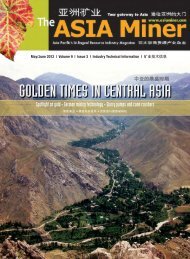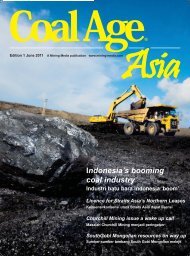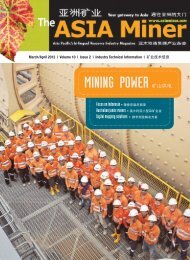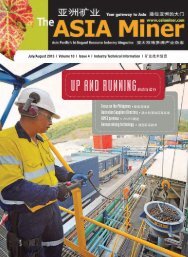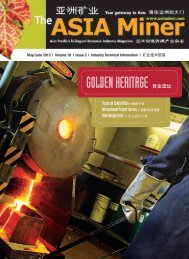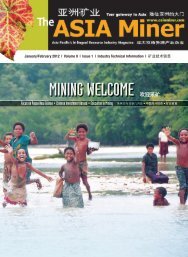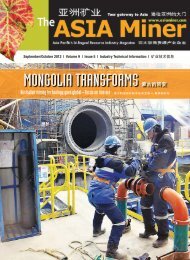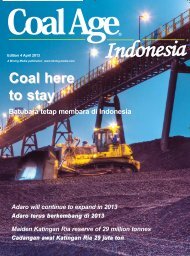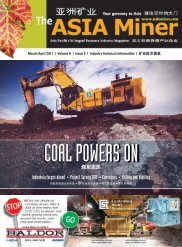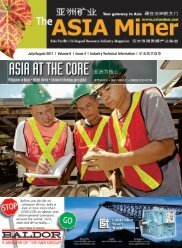Volume 9 Edition 2 2012 - The ASIA Miner
Volume 9 Edition 2 2012 - The ASIA Miner
Volume 9 Edition 2 2012 - The ASIA Miner
Create successful ePaper yourself
Turn your PDF publications into a flip-book with our unique Google optimized e-Paper software.
’<br />
’<br />
Project Survey <strong>2012</strong><br />
Mine Investments by Region, 2011<br />
Investment Share Share Trend<br />
(US$ billion) (Percent) (2010 to 2011)<br />
Africa 099 015<br />
÷<br />
Asia 073 011<br />
Europe 075 011<br />
÷<br />
Latin America 192 028<br />
North America 124 018<br />
Oceania 113 017<br />
TOTAL 676 100<br />
case for Latin America in 2010. North America’s share grew to 18%<br />
and Oceania’s to 17%.<br />
Africa also increased its share of total world investments to 15%<br />
while Europe maintained its position and Asia dropped from 13%<br />
to 11%, continuing a decline that began after reaching a high of<br />
14% in 2009. <strong>The</strong> investment pipeline in North America grew by<br />
$38 billion in 2011, and in Oceania by $32 billion. This represents<br />
44% and 40% for these regions, respectively; much higher than<br />
the global average of 20%.<br />
Latin America’s project pipeline includes many more very large<br />
projects than any other region; for example, 56 Latin American-based<br />
projects involve investments of more than $1 billion, compared with<br />
33 projects in Oceania, 20 each in Africa and Asia, and 17 in Europe<br />
(12 of which are located in Russia and the Ukraine, with the rest in<br />
Sweden and Greenland).<br />
Europe has continued to move up and has passed Asia as the<br />
least favored region, but its relative share remains 11% of the total at<br />
$75 billion. <strong>The</strong> rising investment trend there, with more new projects<br />
in Finland, Sweden, Greenland and in 2011 also in Norway, has<br />
strengthened. <strong>The</strong> European Commission continues to follow the development<br />
of the local mining sector closely and although the new<br />
Raw Materials Initiative has not, to date, resulted in any major new<br />
support initiatives for the European mining sector, the conditions for<br />
the mining industry have not deteriorated.<br />
In Africa, the African Union has continued work on the African Mining<br />
Vision, which aims to create conditions for mining investment in<br />
Africa that enable both the host countries and the investors to benefit<br />
from them. <strong>The</strong> African countries want to take advantage of strong demand<br />
from China to create a competitive situation between traditional<br />
investors from Europe and North America and new Chinese investors.<br />
’ ’<br />
U.S. as a Fading Player Not so Fast…<br />
<strong>The</strong> growing trend toward resource nationalism has manifested itself<br />
in various ways in both emerging and developed mining countries.<br />
Demand for increased royalties or taxes on “super profits” have been<br />
widespread, including established mining nations such as Australia.<br />
Calls for increased state ownership or at least increased ownership by<br />
domestic owners have not been limited to emerging economies such<br />
as Zimbabwe and Namibia; in Finland, the idea of establishing a new<br />
state mining company has been discussed among politicians.<br />
Total investment share attracted by the top 10 countries increased<br />
in 2011 to 71%, passing the previous high of 68% in 2008. <strong>The</strong> trends<br />
mentioned above could be the explanation for a strong growth of projects<br />
in North America and Oceania during 2011. Australia, Canada<br />
and the U.S. together accounted for only 26% of the total project<br />
pipeline at the end of 2010. In December 2011, their combined share<br />
was 34%, with total value up from $150 billion to $223 billion, an increase<br />
of almost 50% in one year. In our 2010 analysis we wrote off<br />
the U.S. as a mining nation and that proved premature.<br />
Australia maintained its position as the number one nation for mining<br />
investments. <strong>The</strong> iron ore boom continues there and of the top<br />
20 projects in Australia, 13 are in iron ore and 11 of them require investment<br />
of more than US$1 billion. Canada, in second place, has a<br />
much wider mix of projects, including several gold and base metal<br />
projects among the top 20, along with five iron ore projects, six gold<br />
projects and two copper projects on the list.<br />
<strong>The</strong> combined announced investment value of projects in those<br />
two nations is slightly less than $100 billion. <strong>The</strong> rest of the Top 10 list<br />
changed considerably in 2011. Chile moved up to rank third, with a<br />
total of $54 billion. Brazilian mining investments fell in 2011 and only<br />
accounted for 7% of the total or $46 billion. Russia recaptured fifth<br />
place in 2011, and even though the number of Russia-based projects<br />
decreased, the investment volume increased by 18%. <strong>The</strong> United<br />
States showed the strongest growth over 2011, up by 38% and rising<br />
from eighth place to seventh. Mexico dropped out of the Top 10<br />
and was replaced by Guinea, where three giant iron ore projects involve<br />
a total investment of $16 billion.<br />
Following the Top 10 in descending order are Mexico, Argentina,<br />
Papua New Guinea, China, Indonesia, Sweden, Democratic Republic<br />
of Congo and Kazakhstan, each with a portfolio of projects between<br />
$8-$13 billion. It should be noted that some projects are much<br />
bigger than others, and one new project announced or one major<br />
project completed in a small country can make a big difference in the<br />
position of this country relative to others. Thus, not too much importance<br />
should be put on relative positions outside the Top 10.<br />
<strong>The</strong> figure for China is most certainly an underestimate, since<br />
many of the projects run by state-owned companies are never reported<br />
in such a way that they reach the international mining press.<br />
With comparable reporting from China there is no doubt that the<br />
country would be high up among the top 10 countries. Chinese<br />
projects are mostly small, with an average investment value of $170<br />
million per project, compared with Canada where the average project<br />
is currently valued at $695 million.<br />
Chinese mining investment activity outside China is still marginal.<br />
China’s scramble for resources in Australia, Africa and elsewhere,<br />
which has come into clearer political focus, still represents minimal investment<br />
values despite rapid growth in recent years—but it is growth<br />
from an almost zero start position. It will take years before Chinese<br />
companies become powerful global players in the mining industry,<br />
but it will eventually happen.<br />
Top 10 Countries for Mining Investment, 2011<br />
Investment Share Rank in<br />
(US$ billion) (Percent) 2010<br />
01. Australia 099 15 01<br />
02. Canada 092 14 02<br />
03. Chile 054 08 04<br />
04. Brazil 046 07 03<br />
05. Russia 046 07 06<br />
06. Peru 044 06 05<br />
07. United States 032 05 08<br />
08. South Africa 025 04 07<br />
09. Philippines 017 03 09<br />
10. Guinea 016 02 11<br />
TOTAL 471 71<br />
22 | <strong>ASIA</strong> <strong>Miner</strong> | March/April <strong>2012</strong>



